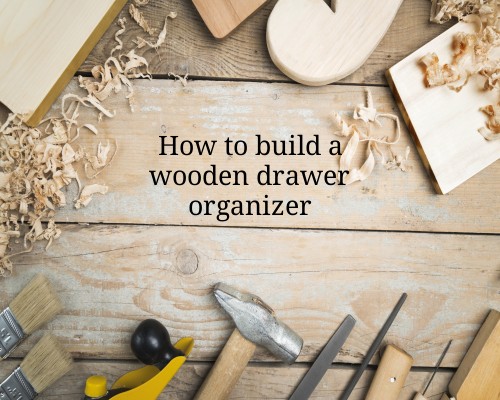Building a wooden drawer organizer is a straightforward woodworking project that can help keep your drawers neat and organized. Here’s a step-by-step guide to help you create your own custom organizer:
Materials Needed:
- Wood (Pine, MDF, or plywood): Depending on the size and durability you want.
- Wood glue
- Screws or nails (optional for added strength)
- Measuring tape
- Pencil
- Saw (Circular saw, table saw, or hand saw)
- Sandpaper or a power sander
- Wood finish or paint (optional)
- Clamps (optional)
Tools Required:
- Saw (Table saw, miter saw, or hand saw)
- Drill (for screws or pilot holes)
- Clamps
- Sandpaper or a sanding block
- Measuring tape
- Wood glue
- Screws or nails
Step-by-Step Process:
1. Measure the Drawer:
Start by measuring the dimensions of the drawer where you want to install the organizer. Measure the width, depth, and height to ensure the organizer fits snugly inside.
2. Design the Organizer:
Think about how you want to divide your organizer. Consider how many compartments or sections you need and their sizes. If you plan to organize small items like cutlery or office supplies, you might want smaller, more detailed sections. For larger items, you’ll need fewer, larger compartments.
- Draw a layout of the organizer on paper or use design software.
- Note the dimensions of each compartment and how many dividers you’ll need.
3. Cut the Wood Pieces:
Using your measurements and design, cut the wood into the necessary pieces:
- Base piece: This is the bottom of the organizer, which will sit on the drawer bottom.
- Side pieces: These form the outer edges of the organizer.
- Divider pieces: These are the internal dividers that will create separate sections.
Make sure all cuts are straight and accurate for a clean fit.
4. Sand the Edges:
Sand the edges of the wood pieces to smooth any rough spots. If you’re using a power sander, it’s quick and easy to get a smooth surface. If doing it by hand, use medium-grit sandpaper first, followed by fine-grit paper for a smooth finish.
5. Assemble the Organizer:
- Apply wood glue to the edges where the side and divider pieces will connect.
- Attach the side and divider pieces to the base, forming the desired grid pattern.
- If using screws or nails, pre-drill small holes to prevent splitting the wood.
- Use clamps to hold the pieces together while the glue dries.
6. Reinforce (Optional):
For added durability, you can add screws or nails to reinforce the joints after the glue has dried. This step is especially important if the organizer will hold heavy items.
7. Finish the Organizer (Optional):
Once the glue has dried and the organizer is solid, you can finish it to protect the wood and enhance its appearance.
- Apply a wood finish, varnish, or paint to give it a polished look.
- Allow the finish to dry completely before placing the organizer in the drawer.
8. Install the Organizer in the Drawer:
Place the completed organizer into the drawer. If everything fits well, you’re done! You can now begin organizing your items.
Additional Tips:
- Customization: If your drawer isn’t a standard size, consider making the organizer modular. You can build smaller sections that can be arranged and rearranged to fit the available space.
- Material Choice: MDF is an affordable and smooth material that is easy to work with, but it can be heavier than plywood or pine. Consider the weight of the organizer relative to the contents.
- Adjustable Compartments: To make the organizer more versatile, you can create slots for removable dividers. This way, you can change the size of the compartments as needed.
Building a wooden drawer organizer is a practical project that enhances the functionality of your home. The result will not only be useful, but it will also be a great opportunity to practice your woodworking skills!
For a comprehensive guide on woodworking projects and detailed plans, check out Teds Woodworking Course here: Teds Woodworking.
